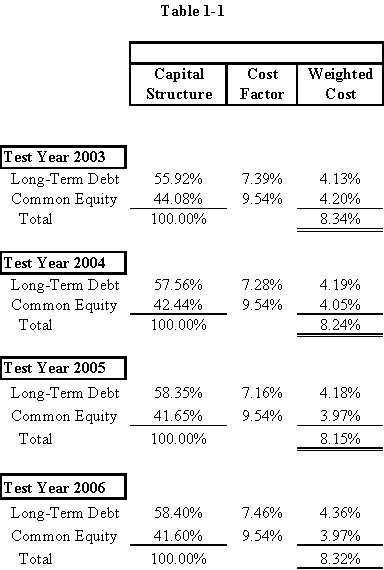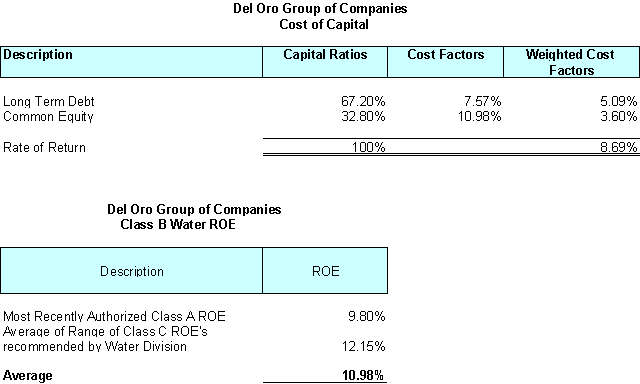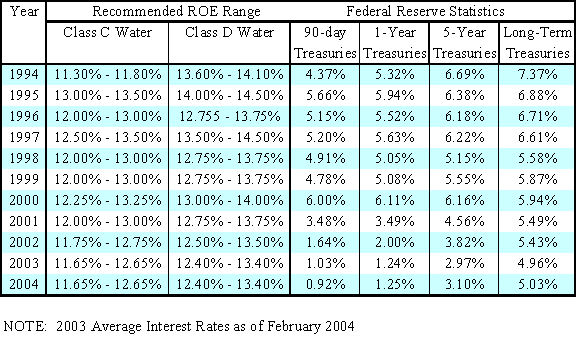|
State of California | |||
|
M e m o r a n d u m | |||
Date: |
May 21, 2004 | ||
To: |
Izetta C. R. Jackson, Director - Water Division | ||
From: |
Public Utilities Commission- San Francisco - Seaneen M. Wilson, FEIV |
||
Subject: |
Concerns regarding how Rates of Return and Returns on Equity are determined for Class A, B, C, and D Water Utilities | ||
Overview
I would like to address two issues in this memorandum - 1) Concerns regarding the determination of a Rate of Return (ROR) for Del Oro Water Company, and 2) Explanation of the specific methods used to determine the ROR for the various classes of water utilities.
Concerns Regarding Del Oro ROR
Prior to the May 6th Commission meeting, an advisor raised concerns regarding the determination of the Rate of Return (ROR) of 8.53% for Del Oro Water Company (Del Oro) (Agenda Item 16 at May 6th Commission Meeting). There was a concern that the ROR for this Class B water utility was 100 basis points lower than ROR's recently authorized for Class A water utilities.
First of all, the recommended ROR for Del Oro is not 100 basis points less than the ROR's most recently authorized for Class A water utilities. In particular, at the May 6th meeting, California-American Water was authorized a ROR of 6.74% (D.04-05-023) and the next most recent authorized ROR is 8.79% for Southern California Water (D.04-03-039). Not only are these returns not 100 basis points greater than that recommended for Del Oro, in the case of California-American, its ROR is 179 basis points lower than that recommended for Del Oro.
Second, as described below, there is a particular method for determining the ROR for each Class of water utility. If the suggested adjustment of a 100 basis point increase is made to the ROR, the Return on Equity (ROE) for this Class B water utility would be greater than that authorized for a Class D water utility, which is not appropriate. (see detailed discussion below)
Methods for determining ROR for Different Classes of Water Utilities
One of the duties of this Commission is to authorize the ROR and ROE for Class A, B, C, and D water utilities. Given the different characteristics of and risks faced by each class of water utility, the ROR and ROE are calculated differently for each.
Class A - 10,000 or more customers
The ROR for Class A water utilities is determined by summing the weighted cost of each component of the capital structure (cost factor times percentage of capital structure). This capital structure is normally made up of long-term debt and common equity. The long-term debt cost is based on the rates each company pays its lenders and the ROE is determined by the Commission after assessing the results of market based models run on a comparable group of water utilities. (Example attached at p. 4 - Table 1-1)
Class B - 2,000 - 9,999 customers
The ROR for Class B water utilities is determined in a similar fashion, except for the calculation of the ROE. Since market data is not available for water utilities comparable to Class B (companies of this size are not publicly traded), staff averages the most recently authorized Class A and Class C ROE's in order to determine the appropriate ROE for a Class B company (see attached tables at p.5 - Class B Tables). The company specific capital structure and cost of long-term debt1 are then combined with this Class A & C average ROE to determine the overall ROR for the Class B water utility.
Del Oro ROR
As the first Class B Table shows (page 5), the ROR calculated for Del Oro is 8.53%. This is based on a combination of the company specific capital structure and cost of long-term debt and the average of the recently authorized Class A and C returns. A suggestion has been made that this company receive a ROR of 9.50%. If this ROR is plugged into that calculation, the resulting ROE would be 13.57%, which is greater than the highest ROE currently being recommended for Class D water utilities of 13.4% (page 6).
Class C & D - C = 500- 1,999 customers / D = 1 - 499 customers
The ROR for Class C and D water utilities is determined based on procedures adopted in D.92-03-093.2 Since most Class C and D water utilities do not have any long-term debt, (or, if they do it is covered by a principal and interest surcharge and not included in rates) their total capital structure consists of common equity. The ROE that is determined for Class C and D water utilities is also the ROR. Per D.92-03-093, each year the Water Division reviews the movement of interest rates in the past year as well as ROEs authorized for Class A water utilities to determine the appropriate ROEs for the Class C and D water utilities. (See attached March 1, 2004 memo) If there is material movement up or down in interest rates or the authorized Class A ROE's, then the range of ROEs recommended for Class C and D water utilities is adjusted in the same direction. A range of ROE's is provided so that the analyst can consider the specific risks faced by each individual company in a particular class.3
If you have any questions or would like to learn more about cost of capital for water utilities, please contact me at 415-703-1818 or smw@cpuc.ca.gov.

Class B Tables

|
State of California | ||||
|
M e m o r a n d u m | ||||
Date: |
March 1, 2004 | |||
To: |
The Commission | |||
From: |
Kenneth K Louie, Chief, Audit & Compliance BranchIzetta Jackson, Director, Water Division |
|||
Subject: |
Rate of Return for Small Water Utilities (Class C and Class D) | |||
This memorandum updates the Water Division's recommended rates of return for Class C (<2,000 customers) and Class D (<500 customers) water companies, as required by D.92-03-093 in Phase I of I.90-11-033 (Water Risk OII).
Based on our analysis of financial market changes within the last year and the high operational risks faced by Class C and Class D water companies, we are recommending no change in the return ranges for Class C and Class D water utilities informal general rate cases. For 2004, we are recommending Return on Equity (ROE) ranges of:
Class C - 11.65% to 12.65% (no change from last year)
Class D - 12.40% to 13.40% (no change from last year)
In setting rates of return for other utilities, the Commission has recognized changes in interest rates as well as the economy generally. At the same time, the Commission has cautioned against lock-step conformity to these factors. The Water Division's Audit & Compliance staff has developed its recommendations accordingly.
· Financial Market Outlook: Overall, interest rates have decreased since last year. As of February 2004:
o The average yield on 90-day Treasury Bills is .92%, as compared to 1.03% for 2003, representing an 11 basis point decrease;
o The average yield on a 1-Year Treasury is 1.25%, as compared to 1.24% for 2003, representing a 1 basis point increase;
o The average yield on a 5-Year Treasury is 3.10%, as compared to 2.97% in 2003, representing a 13 basis point increase: and
o The average Long-term Treasury is 5.03%, as compared to 4.96% in 2003, representing a 7 basis point increase.
o It should also be noted that the interest rate forecasts for 2004 are somewhat higher than those experienced in 2003:
· 90-day Treasury bill is forecast to be 1.10%,
· 1-Year Treasury is forecast to be 1.57%,
· 5-Year Treasury is forecast to be 3.39%, and
· Long-Term Treasury is forecast to be 5.30%.
In developing its ROE recommendations, Water Division's Audit & Compliance staff also observes any changes from the previous years authorized returns for Class A water companies.
· Authorized ROE's for Class A water utilities have remained fairly constant since last year, averaging 9.93% in 2003.
Water Division staff also evaluates the high risk factors inherent in the Class C and Class D water companies, taking into account that:
· ROE should be high enough to encourage rate base investment, and
· ROE should be well above the cost of debt. This compensates owners of small water companies for financing water plant with personal borrowings, which is risky. Small water companies are still prone to business failures and uncompensated takeovers.
In D.92-03-093, the Commission has allowed rate of return to be set at a level above or below the recommended ranges if warranted by the facts of a particular case and established the 1992 standard returns shown for Class C and Class D water utilities. Thus, our recommended returns are stated as "ranges" so that Water Division staff may recognize differences in such items as water and service quality and management effectiveness, on a case-by-case basis. Since that time, several risk-reducing Commission policies have been added, including Automatic CPI offset procedure, Extraordinary expense memo accounts, Catastrophic Event Memorandum Account, Service Guarantee Plan, and Purchased Power/Water balancing accounts.
The table below provides a historical perspective on the recommended return on equity for the small water companies. Any questions regarding this recommendation may be directed to Sean Wilson of the Water Division (1-415-703-1818, smw@cpuc.ca.gov).

